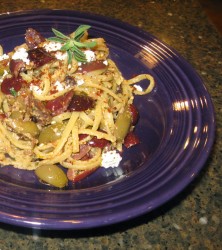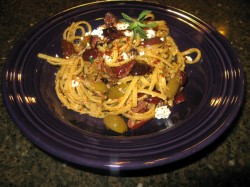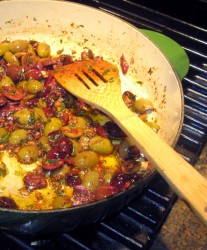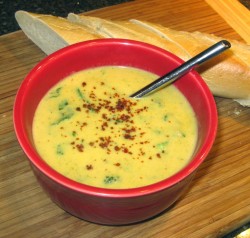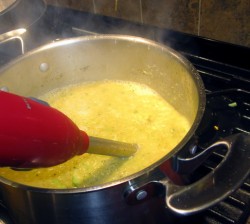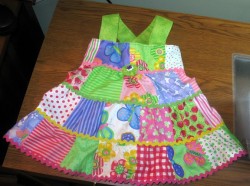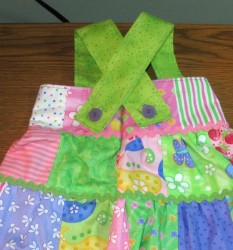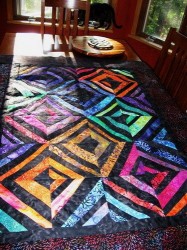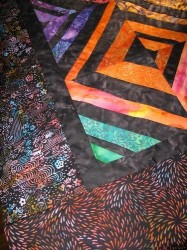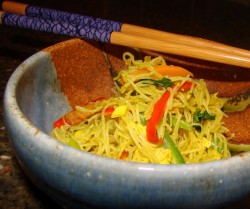Another Vegetarian Pasta: Linguine With Olives, Lemon and Feta
This simple pasta dish is redolent with the voluptuous flavors and aromas of Greek cuisine and is the result of my attempts to have our household eat vegetarian meals several times a week. The reasoning behind this attempt is not only because I believe that eating even less meat than we already do is healthier, but also because it saves money, and often, time in the kitchen. (With all of this sewing I am doing, sometimes it is really nice to have a quick meal to fall back on and often, vegetarian pasta fits the bill.)
This dish came about because I wanted a recipe to feature the delicious salty-milky savor of the locally produced goat feta that I buy from Chris Chmiel of Integration Acres. Chris makes rich, unctuously creamy chevre, but I think that I like his feta even better–it is tangy, salty without being overwhelmingly briny and richly milky, all without that unpleasantly chalky texture that commercially produced feta can sometimes have. His feta is always firm and crumbly without being rubbery, with a soft, melting mouthfeel that is satisfyingly velvety.
In other words, his feta is to die for.
And I wanted to do another pasta dish to feature it, and since I had some green Nafplion and black Kalamata olives in the fridge, and lemons piled in a cobalt blue bowl on my dining room table, I thought that I just might have to combine the three into a simple, easy and fast to make sauce for linguine, my new favorite pasta shape. With the addition of a liberal dose of fresh herbs: thyme, oregano and rosemary, a bunch of fresh, locally grown garlic, and a heavy sprinkling of Aleppo pepper flakes, the contours of the recipe began to take shape.
One caveat about this recipe is that it all comes together very quickly–so do all of your prep work before you step up to the stove. As in Chinese stir-frying, it is crucial that your mise en place is all done and ready to go before you start cooking for this recipe to be successful, so before you turn that burner on under your pan of olive oil, make sure that your garlic is all minced, your olives are all sliced and pitted, your feta is crumbled, your lemons are zested and her herbs are stemmed and minced.
Also, start your water boiling for your pasta, and have it boiling when you start cooking the sauce. When the sauce is nearly done, put the linguine in to cook–you don’t want it to be done before the sauce–pasta that sits and waits for the sauce is liable to get sticky, rubbery and just plain not good, whereas most sauces can wait a few minutes for pasta to cook without any ill effects–in fact a few more moments on very low heat more often than not improves a pasta sauce.
A note about the olives–I use pitted Greek olives here, because I hate pitting them. You can use any kind of olive you want in this, but I think the Greek ones are best–green brine cured Nafplion and rich violet-black brined Kalamatas are my favorite, and I highly suggest you use them, but if you don’t want to, that is up to you. Just know that if you use typical pimento-stuffed Spanish green Manzanilla olives and canned black California olives, your pasta sauce won’t have as much flavor and character as it would if you used the Greek olives.
If you don’t have Aleppo pepper flakes, you can use a smaller amount of any other kind of chili flakes, or use freshly ground black pepper instead.
Linguine With Olives, Lemon and Feta
Ingredients:
3 tablespoons olive oil
2 1/2 tablespoons minced fresh garlic
1 1/2 teaspoons Aleppo pepper flakes
1 cup pitted Kalamata olives, sliced in half longitudinally and lightly rinsed and drained to remove excess salt
1/4 cup lemon zest, divided
2 tablespoons minced fresh oregano, divided
2 tablespoons minced fresh thyme leaves, divided
2 tablespoons minced fresh rosemary, divided
1 cup Nafplion olives, rinsed, drained, pitted and sliced in half longitudinally
1/8 cup lemon juice
2 tablespoons heavy cream (optional)
3/4 cup crumbled feta cheese
1 pound cooked, drained linguine
sprigs of oregano , extra feta cheese crumbles, extra lemon zest and sprinklings of Aleppo pepper flakes for garnish
Method:
Heat olive oil in a heavy-bottomed skillet on medium heat. After a minute or so, add garlic and Aleppo pepper flakes, and cook, stirring, until the garlic is golden and fragrant. Add Kalamata olives and 1/2 of the lemon zest as well as 1 tablespoon each of the fresh oregano, thyme and rosemary. Cook, stirring, for about three minutes, then add the green Nafplion olives and cook for another minute or so.
Stir in the lemon juice, the other half of the lemon zest, and the rest of the herbs, as well as the heavy cream and 1/2 of the feta.
Add the linguine, turn off the heat and toss thoroughly, adding the rest of the feta. Toss until the pasta is coated with the flavored oil and the melted cheese, and the olives, herbs and lemon zest are thoroughly mixed with the pasta.
Twirl into warmed bowls and garnish with sprigs of oregano, crumbled feta, lemon zest and Aleppo pepper flakes.
This is great served with a salad of mixed greens with a simple herb, lemon juice and olive oil dressing garnished with pine nuts or walnuts.
Soup Is A Truly Frugal Dish: Broccoli-Cheese and Kale Soup
Soup is not only one of the most soul-satisfying meals out there, but it is also generally truly frugal.
I grew up eating a lot of home-made soups, and all of them started off as ways to make use of leftovers, or something that we had in surplus, or were made to feed a lot of people very cheaply. Making soup is the perfect way to use every scrap of food, to eke every smidgen of flavor and to coax every little bit of nutrition from every component, and as such, putting together a pot of soup is the perfect way to make do with what you have.
And in these trying financial times, making do is a good skill to cultivate.
The soups I grew up eating were most often based on the bones of an animal carcass–a roasted turkey or chicken, or the big shank bone of a ham. Or the ribs from a batch of beef short ribs. They were created as ways to use up every little bit of food possible, because we weren’t wealthy when I was a kid, and both sets of grandparents had lived through the Great Depression, so the ways of frugality came naturally to my parents.
Cooked with the meat bones were beans, lentils and vegetables–and the truth is this–the soup was based on bones, but meat made up a very small percentage by weight of the bulk of the soup. Most of the volume of our soups was made up of vegetables–some of them a bit past their prime.
And that is perfectly fine and dandy. Potatoes that have started to sprout and have gone a bit soft make gluey mashed potatoes and are nasty fried, but if you boil them in a soup, they are fine. (Remove the shoots and sprouts first, though, obviously!) Carrots that are too big and woody to be eaten in a salad taste fine boiled in a soup. Celery that has gotten too rubbery to put into potato salad still lends delicious flavor to soup. And over-ripe tomatoes that are too squishy to cut into slices are just fine simmered into a soup.
Sometimes, you can use parts of vegetables that you would not normally eat in soup, thus using every scrap of nutrition available in the plant.
Take, for example, the case of broccoli stalks.
Those big, tough, woody green stems are discarded in most kitchens, but not mine. In addition to peeling and eating them raw–the celadon-colored slices are sweet and crisp–or using them in stir-fried dishes, especially kung pao chicken, just as China Fortune, here in Athens does. The sweetness of the stalks goes beautifully with the spicy sauce, and the color is very pretty in the dish, contrasting nicely with the brick red dried chilies.
I also use broccoli stalks to make the basis for a creamy broccoli-cheese soup–arguably a favorite soup among Americans–that doesn’t need to use much in the way of cream to make it smooth, nor does it rely on any roux, flour or cornstarch to thicken it. The broccoli stalks, with a little help from some potatoes–preferably some which have gone a bit soft and sprouty–and sometimes some leftover rice, make a deliciously, velvety smooth soup base with superior flavor and no floury-aftertaste. AND–this tasty soup comes without the added calories from refined starches or extra fat from roux.
And it all couldn’t be simpler, more frugal or more satisfying to both the stomach and the wallet, because I am using stuff that might otherwise get thrown out.
Being frugal feels awfully good, especially when the result is a creamy soup that is surprisingly light.
How do I go about making this superior soup?
Well, I talk the broccoli stalks and peel the tough, stringy outer skin off with a vegetable peeler, and into the compost pile. Then, I slice off the nasty, tough end of the stalks and send that out to the compost, too. Then, I just cut them up into 1/4″ thick slices, along with some of the florets and smaller stalks of my broccoli. (I only use about half of the upper head of the broccoli in the soup base. The rest is cut up into small spoon-sized bits to be added to the soup at the very end so the broccoli barely cooks and is served bright green and tender-crisp.
Then I also peel and de-stalk the rather seedy-looking potatoes and cut them into chunks.
And then I cut about three cups of thinly sliced onions, and peel and mince five cloves of garlic. I melt 3 tablespoons of butter in the soup pot, saute the onions until they are a deep golden brown, add the garlic, keep cooking and stirring and do that until the onions are a deep reddish brown. Then, I add herbs and seasonings, and either wine or beer to deglaze the pot. Then, in goes vegetable broth, and the cut up bits of broccoli stalk and florets and the potatoes. If I have leftover rice cold in the fridge, I toss in a cup or so of that as well.
I make sure that the vegetables are just covered by the broth and I bring it to a simmer, and let everything cook until the vegetables are fork tender.
While that is going on, I grate every bit of cheese I have laying around the house. This is the perfect way to use up oddments of cheese, and nearly every cheese tastes great in this soup, though this time around, I used a bit of havarti, butterkaese, and sharp cheddar. But you can use anything you have around.
When the vegetables are softened., I take the pot off the heat, pull out my trusty immersion blender and puree everything in the pot. I make sure to keep going until everything is smooth–no lumpy bits please! Then, I take my shredded cheese and sprinkle it into the soup -while the blender is still going- which is the best way to get the cheese to melt quickly and emulsify in the soup without having to bind everything with roux. Once the cheese is fully incorporated, I add about a half cup to a cup of half-and half or cream to the soup, correct the seasoning (cheese is salty, so there is no sense in adding salt until you can taste the soup with the cheese), and then stir in the broccoli. I turn the fire back on the lowest setting and stir for about three minutes, or until the small bits of broccoli floret are quite tender and the green has brightened considerably.
And then, voila! I serve it forth.
I did do something different when I made the soup last night–I added finely shredded kale leaves at the very end after the broccoli florets had been in the soup for about a minute. I had some kale sitting around and decided that it would taste great in the soup and lo and behold, I was right. The leaves were sweet, yet slightly bitter and mixed beautifully with the nutty cheeses, and the deeper green went nicely with the brilliant emerald florets.
Served with toasted baguette, this soup was a satisfying in every way–to the senses, to the stomach, and the soul.
Creamy Broccoli Cheese and Kale Soup
Ingredients:
2 tablespoons butter
3 cups thinly sliced onions
1 teaspoon salt
5 cloves garlic, peeled and minced
1 teaspoon dried thyme or 1 tablespoon fresh
1 tablespoon Aleppo pepper flakes or freshly ground black pepper to taste
1 teaspoon dried or one tablespoon fresh tarragon leaves (minced if fresh)
1/3 cup beer, white wine or sherry (I used sherry, but prefer beer)
2 quarts vegetable broth
large stalks from 2 pounds broccoli, peeled, trimmed and sliced into 1/4″ rounds
1/2 of the smaller stalks and florets of the 2 pounds of broccoli, cut into small pieces (cut the rest into very small pieces and reserve for later)
5 medium potatoes, peeled and cut into slices
1 cup cold, cooked basmati or jasmine or other long-grain rice
1/2-1 cup heavy cream or half and half
4 cups shredded mixed cheeses (sharper cheeses are better for this purpose)
the reserved broccoli florets
3 cups thinly sliced kale leaves
salt to taste
Aleppo pepper flakes for garnish
Method:
Melt butter in a heavy-bottomed soup pot on medium heat. Add onions and sprinkle with salt. Cook, stirring, until the onions are a deep golden brown. Add garlic, thyme, Aleppo pepper and tarragon, and cook, stirring, until the onions are a deep reddish brown–about four more minutes.
Deglaze the pot with the beer, wine or sherry, and when the alcohol has boiled off, add the broth. Add the broccoli stalks, potatoes and the first bunch of florets, and simmer until the vegetables are fork-tender.
Turn off heat and using an immersion blender, puree the soup until it is perfectly smooth. Incorporate the cream while the blender is running, and melt in the cheese with the blender.
When the cheese is blended and melted, add the reserved broccoli, let it cook for a minute, then add the kale and let cook for two minutes. Taste for salt and correct seasoning as needed.
Sprinkle each serving with Aleppo pepper and serve with toasted bread or croutons.
Note: You can use lots of other vegetables in this soup. You could add some celery, or some carrots to the soup base to be pureed in, but not much because they are strong in flavor. You can add a bit of turnips, too–but only if they are fairly sweet.
Also, instead of the cream or half and half, you could use Greek style yogurt or sour cream to add a tangy note to the dish.
Either one would be spectacular. It all depends on what is in your pantry that needs to be used up when this soup is on the stove!
This Week’s Sewing Project: Kat’s Patchwork Dress
This sweet little dress is probably the most complicated garment I have made in years.
Which is sad, because it is really simple!
I made it using this pattern–Little Charmers from Indygo Junction. As is usual, I changed it considerably from the way it was written. The pattern calls for much more fabric, and much less embellishment, and the way the construction is written is somewhat confusing, but as you can see, I muddled through!
And, as you can see, I even made buttonholes, which is really easy using my Bernina 440 QE’s automatic buttonhole foot. Well, in theory, anyway. The truth is, when I first connected the foot and started practicing making buttonholes, the thing didn’t work. It would make one side of the buttonhole and then would refuse to do anything else but make a big knot of thread on the top and bottom of the fabric. Nice.
It turns out that the computer chip in the foot and the computer on my machine, Heidi (yes, I named my sewing machine) were not talking to each other. They were just not on speaking terms, so yesterday, I drove an hour to Lancaster, to get them back to the dealer and they intervened and calibrated the two, so now they get on famously. And they make some pretty awesome buttonholes!
Of course, the upshot of all of this is that I had her at the dealership yesterday, and that was great. After I finished this dress, and did some alterations on that patchwork dress I made Kat last year so that she can still wear it as a top (I took off the velcro strap closure and sewed on rainbow ribbon ties, and I added a bit of rainbow rickrack to the waist to fresh it, and then I let out the straps a bit) I did a tiny bit of quilting for a plush zombie rabbit Britney is making, and lo and behold, the little oilcan graphic that indicates Heidi has reached her 100, 000 mile mark and needs to go in for a professional oiling and cleaning popped up and started flashing.
I was like, “Girl, why didn’t you tell me this while I had you there already?”
So, back she goes tomorrow. Silly machine.
But at least I got the dress done. When I tried to do the buttonholes on Friday night and they wouldn’t work, I nearly cried from frustration! But, it all went well. The dealership happened to still be open and I called and described the problem and they knew right away what was happening and told me to bring everyone in the next day and I could have it fixed in no time. And that is how it all worked.
While we were there, Britney and I saw a lovely vintage sewing machine from 1969, cabinet and all accessories included, sitting on the floor. It is in perfect working order and is the cleanest vintage piece I have ever seen. The owner of the shop, who also fixes old machines said he doubted that the woman ever used it–and that he hardly had to do anything but clean and oil it.
It is for sale and since he couldn’t get parts for Gram’s old machine to fix it, I am tempted.
Since I have to go back on Monday anyway, I will thread it up and see how it works, and I might pick it up for Morganna and Britney to use. Britney is very interested in learning to use a machine and Morganna is somewhat interested, so we will see what happens.
Another Sewing Project: Morganna’s Quilt
Here is a photo I wanted to post back in August, when I finished it, but I couldn’t because it was to be my big gift to Morganna for Generic Winter Holiday. (Considering we are a household that includes a Buddhist, an atheist, an agnostic and a Jew, and we are celebrating Hanuka, Yule, and Christmas all at once, we just give the whole shebang a rather droll title and leave it at that.) This year, I made gifts for almost everyone on my list, and this quilt–which you see here as only the pieced top–was the largest gift I made.
Now, the reason you only see the pieced top is because I took it to Susan at The Nelsonville Quilt Company to have her quilt it on her longarm machine, because I am just not competent to quilt something that big on my regular sewing machine.
Anyway, let’s talk about the quilt itself–I saw the design in a magazine and decided that I loved the design, but hated the execution. The designer picked boring fabrics and didn’t vary the width of the strips enough to suit my fancy, so I did it my way. All of the fabrics are batiks or hand-dyes–and I have no clue how many different fabrics are in here. I raided my stash and scrap bag and bought a remarkably few pieces of fabric specifically for this project.
The colors are fantastic, as you can see–brilliant oranges, fuchsias, greens, blues, indigos, violets–yellows–they are all there, along with burnt umbers and golds. I used the black hand-dye as the unifying theme, and I carefully chose individual pieces of fabric to give the illusion that parts of the design are melting into each other. It adds to the psychedelic swirl effect that is mixed with a fractured mirror look.
Which is why I called it “Fractured Fortunes.” Morganna has had a hard, sometimes twisting road toward adulthood, and sometimes the journey has made her feel cracked and broken, but she has emerged as brilliant and beautiful as the fabrics in this quilt, and I know that like this quilt, she will be a sum greater than her parts.
Here is a detail of the corner of the quilt showing that I used four different black and multi-colored batiks for the wide outer border, thus carrying on the crazyquilt scrapbag look and feel of the whole piece.
When she comes back for Spring Break next week, I will photograph the whole quilt to show you the exquisite fabric that Susan and I found for the backing and the delicious multicolored freehand quilting design she did. She did an amazing job, she really did.
I am proud to say that Morganna absolutely loves the quilt and I get a swell of pride every time I see her wrapped up in it or overhear her showing it off to a dorm mate, proudly telling them that “this is what Mom made me for Christmas.”
Feeding a Toddler During a Growth Spurt
Kat has the most dramatic growth spurts I have ever seen.
I didn’t have big growth spurts, exemplified by periods of eating like a horse and sleeping long hours, until I was a pre-teen and a teen. I remember the summer I was twelve, being so hungry at my Grandma’s farm, that I could literally eat two hamburger patties, a pile of mashed potatoes and beef gravy, FIVE ears of corn, a passel of tomato slices and two helpings of green beans, plus a piece of cake or pie or a cookie for dessert. For lunch.
And nearly as much at dinner, and certainly that much at breakfast.
Sure, I was running around like a mad creature, playing basketball, chasing dogs, swimming in the pond, climbing trees, racing through the woods, not to mention hoeing garden rows, feeding cows and chickens, helping build pole bean trellises, staking tomatoes and other assorted chores. I know I burned a lot of those calories, but I also slept a lot, and I remember my long bones–the ones in my arms and legs–aching. If I wasn’t moving, I would fall asleep.
I remember Mom taking me to the doctor, and he just laughed and showed her how much taller I had become since my last checkup, and he asked if my arms and legs hurt and he said, “She’s grown three and a half inches in height in a few months, Mrs. Fisher. No wonder she eats so much and sleeps a lot. Growing happens when a child sleeps. Stop worrying about her.”
When I was little, even though I always had a good appetite, my growth was much less dramatic and slower.
Morganna was the same way–she didn’t do dramatic growth spurts until she was a teenager. Then, she started shooting up in height, and put on muscle. And she ate and slept a lot, just like I did.
Not so Kat. She is growing almost so fast you can see it happen before your eyes.
I guess it is because she was a preemie–her body is working hard to catch up with itself.
But, you know how everyone says that toddlers barely eat anything and yet still buzz around like little hummingbirds?
Not so Kat.
She can eat six silver-dollar sized waffles with real maple syrup and blueberries at a sitting. With a whole adult-sized piece of bacon.
And then she tucks into dehydrated strawberries. She can eat a whole apple at a sitting, and not a little one, either. A nice handful-sized one.
Her favorite lunch is either refried beans or black beans and rice or the ever-beloved “Cheesy Rice” which is a casserole of fresh broccoli florets and tiny stalks, chopped fine, jasmine rice and a heavy cheese sauce with gouda, sharp cheddar, havarti and Parmesan flavored with garlic, mild chilies, a bit of mustard, chives, shallots and tarragon. She can eat an inordinate amount of that stuff–which is fine–it is delicious and good for her, filled with dairy protein, and since she doesn’t drink cow milk, it is great for her.
For dinner, she usually eats what we do, and her favorites are stir fried Chicken with Bacon and Bok choy–or any kind of stir-fried chicken for that matter, so long as there is plenty of jasmine rice involved. And carrots and snow peas–she has decided she loves those. Peas are especially good in Pasta with Prosciutto and Peas. That is a favorite. Or chicken curry. Or Singapore rice noodles with chicken. Or ham. Or quesadillas with refrieds, shredded pork and cilantro–she loves cilantro. And scrambled eggs with cheese–all of these are big favorites for dinner time.
She also likes fried catfish or fried chicken, but we don’t have those too often. Homemade macaroni and cheese is beloved. Spaghetti is a classic that she cannot help but love, no matter how it is sauced
When she is growing, her hunger becomes urgent and her mood will spiral down into a tantrum quickly if her stomach suddenly becomes empty. I try to avoid this by having bits of bread, shreds of raw carrot, diced apple or dehydrated strawberries around to keep her snacked up so she doesn’t suddenly freak out for lack of food.
And then she eats a substantial snack before bed. Often a scrambled egg with herbs and cheese–a lazy Mom’s omelet, in other words, or a bowl of MiniWheats with milk–this is the only context in which she will drink milk–with cereal in a bowl. Sometimes she will have a bit of peanut butter with bread or a grilled cheese sandwich. Matzo ball soup with chicken is also highly favored.
And she is not a chubby kid at all–if anything, she is quite slender.
Now, I will say, we can always tell when the growth spurt stops, because she will go back to eating like a regular toddler. She will become pickier, and will eat only a small amount, though her mood is still quite dependent on how much she eats and when.
I can’t wait until spring and summer come–because then we can go back to feeding her fresh local strawberries and blueberries–two of her favorites from last summer. And fresh corn on the cob–she loves that, though last year she ate it raw! And cherry tomatoes–she loves those, too–I can’t wait!
I feel blessed that I have a little girl who eats such a wide variety of foods–it makes it easier to be certain that she is getting a wide variety of nutrients.
The one food group she doesn’t eat much of is fish–so she gets supplements of cod liver oil that is certified to be free of mercury, and is refined to remove the fishy taste. It has been infused with orange oil, so I put it in her orange juice in the mornings. The omega-3 fatty acids in this supplement are essential for brain development, about which I will write more later.
I am just amazed at how fun it is to feed this little creature. Her higher nutritional needs reminds me to eat, too–I am still losing weight, but I find that my mood is much better when I do eat regularly. Kat reminds me to eat at decent intervals and to eat nutritious foods. I have to be a good example for her, after all.
But lest you think that it is all healthy food around here, I have to tell you that Kat and I like to share chocolate ice cream, a shortbread cookie or two and kettle cooked potato chips or fresh tortilla chips from time to time, too.
I don’t want her to fetishize “junk” foods because they are forbidden. I want her to learn to eat all foods in moderation, and to not over-value foods if she is denied them.
I guess my method of toddler feeding is all about balance–and I think that is a good thing.
Powered by WordPress. Graphics by Zak Kramer.
Design update by Daniel Trout.
Entries and comments feeds.

